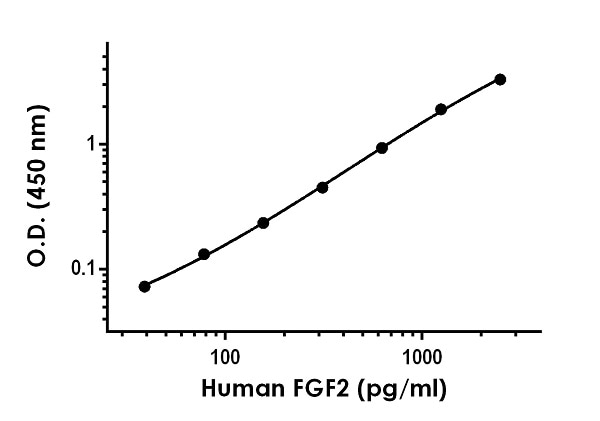Human FGF2 ELISA Kit (ab246531)
Key features and details
- One-wash 90 minute protocol
- Sensitivity: 4 pg/ml
- Range: 15.625 pg/ml - 2500 pg/ml
- Sample type: Cell culture extracts, Cell culture supernatant, Cit plasma, Hep Plasma, Serum, Tissue Extracts
- Detection method: Colorimetric
- Assay type: Sandwich (quantitative)
- Reacts with: Human
Overview
-
Product name
Human FGF2 ELISA Kit
See all FGF2 kits -
Detection method
Colorimetric -
Precision
Intra-assay Sample n Mean SD CV% Extract 8 3.7% Inter-assay Sample n Mean SD CV% Extract 3 1.8% -
Sample type
Cell culture supernatant, Serum, Cell culture extracts, Tissue Extracts, Hep Plasma, Cit plasma -
Assay type
Sandwich (quantitative) -
Sensitivity
4 pg/ml -
Range
15.625 pg/ml - 2500 pg/ml -
Recovery
Sample specific recovery Sample type Average % Range Cell culture supernatant 95 84% - 104% Serum 103 101% - 106% Cell culture extracts 117 103% - 125% Cell culture media 110 101% - 115% Hep Plasma 95 89% - 105% Cit plasma 95 92% - 100% -
Assay time
1h 30m -
Assay duration
One step assay -
Species reactivity
Reacts with: Human -
Product overview
Human FGF2 ELISA Kit (ab246531) is a single-wash 90 min sandwich ELISA designed for the quantitative measurement of FGF2 protein in cit plasma, hep plasma, serum, cell culture extracts, tissue extracts, and cell culture supernatant. It uses our proprietary SimpleStep ELISA® technology. Quantitate Human FGF2 with 4 pg/ml sensitivity.
SimpleStep ELISA® technology employs capture antibodies conjugated to an affinity tag that is recognized by the monoclonal antibody used to coat our SimpleStep ELISA® plates. This approach to sandwich ELISA allows the formation of the antibody-analyte sandwich complex in a single step, significantly reducing assay time. See the SimpleStep ELISA® protocol summary in the image section for further details. Our SimpleStep ELISA® technology provides several benefits:
- Single-wash protocol reduces assay time to 90 minutes or less
- High sensitivity, specificity and reproducibility from superior antibodies
- Fully validated in biological samples
- 96-wells plate breakable into 12 x 8 wells stripsA 384-well SimpleStep ELISA® microplate (ab203359) is available to use as an alternative to the 96-well microplate provided with SimpleStep ELISA® kits.
-
Notes
Abcam has not and does not intend to apply for the REACH Authorisation of customers’ uses of products that contain European Authorisation list (Annex XIV) substances.
It is the responsibility of our customers to check the necessity of application of REACH Authorisation, and any other relevant authorisations, for their intended uses. -
Platform
Pre-coated microplate (12 x 8 well strips)
Properties
-
Storage instructions
Store at +4°C. Please refer to protocols. -
Components 1 x 96 tests 10X Human FGF2 Capture Antibody 1 x 600µl 10X Human FGF2 Detector Antibody 1 x 600µl 10X Wash Buffer PT (ab206977) 1 x 20ml 5X Cell Extraction Buffer PTR (ab193970) 1 x 10ml Antibody Diluent 4BI 1 x 6ml Human FGF2 Lyophilized Recombinant Protein 2 vials Plate Seals 1 unit Sample Diluent 25BP 1 x 20ml Sample Diluent NS (ab193972) 1 x 50ml SimpleStep Pre-Coated 96-Well Microplate (ab206978) 1 unit Stop Solution 1 x 12ml TMB Development Solution 1 x 12ml -
Research areas
-
Function
Plays an important role in the regulation of cell survival, cell division, angiogenesis, cell differentiation and cell migration. Functions as potent mitogen in vitro. Can induce angiogenesis (PubMed:23469107). -
Tissue specificity
Expressed in granulosa and cumulus cells. Expressed in hepatocellular carcinoma cells, but not in non-cancerous liver tissue. -
Sequence similarities
Belongs to the heparin-binding growth factors family. -
Post-translational
modificationsPhosphorylation at Tyr-215 regulates FGF2 unconventional secretion.
Several N-termini starting at positions 94, 125, 126, 132, 143 and 162 have been identified by direct sequencing. -
Cellular localization
Secreted. Nucleus. Exported from cells by an endoplasmic reticulum (ER)/Golgi-independent mechanism. Unconventional secretion of FGF2 occurs by direct translocation across the plasma membrane. Binding of exogenous FGF2 to FGFR facilitates endocytosis followed by translocation of FGF2 across endosomal membrane into the cytosol. Nuclear import from the cytosol requires the classical nuclear import machinery, involving proteins KPNA1 and KPNB1, as well as CEP57. - Information by UniProt
-
Alternative names
- Basic fibroblast growth factor
- Basic fibroblast growth factor bFGF
- BFGF
see all -
Database links
- Entrez Gene: 2247 Human
- Omim: 134920 Human
- SwissProt: P09038 Human
- Unigene: 284244 Human
Images
-
SimpleStep ELISA technology allows the formation of the antibody-antigen complex in one single step, reducing assay time to 90 minutes. Add samples or standards and antibody mix to wells all at once, incubate, wash, and add your final substrate. See protocol for a detailed step-by-step guide.
-
The FGF2 standard curve was prepared as described in Section 10. Raw data values are shown in the table. Background-subtracted data values (mean +/- SD) are graphed.
-
The FGF2 standard curve was prepared as described in Section 10. Raw data values are shown in the table. Background-subtracted data values (mean +/- SD) are graphed.
-
The FGF2 standard curve was prepared as described in Section 10. Raw data values are shown in the table. Background-subtracted data values (mean +/- SD) are graphed.
-
The concentrations of FGF2 were measured in duplicates, interpolated from the FGF2 standard curves and corrected for sample dilution. Undiluted samples are as follows: K562 supernatant 50%. The interpolated dilution factor corrected values are plotted (mean +/- SD, n=2). The mean FGF2 concentration was determined to be 52.66 pg/mL in neat K562 cell culture supernatant.
-
The concentrations of FGF2 were measured in duplicate and interpolated from the FGF2 standard curve and corrected for sample dilution. The interpolated dilution factor corrected values are plotted (mean +/- SD, n=2). The mean FGF2 concentration was determined to be 227.9 pg/mL in HeLa cell extract.
-
To learn more about the advantages of recombinant antibodies see here.




















